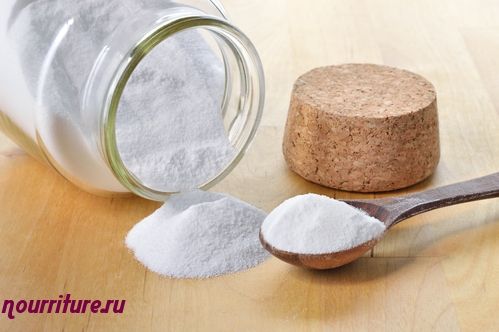
Interesting facts about food → Treatment of cancer with soda (treatment of oncology with soda): the unique properties of soda (Na HCO3 sodium bicarbonate, soda).
Sodium bicarbonate (Na HCO3), or baking soda, has been known since Soviet times as an excellent cleaning agent for sinks and dishes, as well as a good means for loosening dough. Of course, a modern baking powder that replaces soda when baking cookies and cakes does not give the dough an unpleasant aftertaste, however, as studies by German scientists have shown, its medicinal properties and, in general, the effect on the human body cannot be compared with soda. So, let's start with the fact that if earlier soda was often prescribed to patients with fractures, now it is recommended for use by people suffering from cancer. It is important to note that we are talking about pure, natural soda, without any additives, and in this sense, the baking powder is unable to replace it since it contains compounds containing aluminium and phosphate oxidizing substances.
Baking soda is a natural product. It was discovered in 1840 and at first, was used exclusively in bakeries, and then, already in the twentieth century, it fell into frequent households and began to be used for baking bread and pastries.
People soon noticed that baking soda has other beneficial properties, for example, it helps with the flu, colds and chronic inflammation. This is easy to explain since baking soda is an alkali with a high pH level. Therefore, it can be used as a therapeutic agent by people with high acidity, because the pH level in their tissues tends to be low.
Treatment of cancer (oncology) with soda: the unique properties of soda (Na HCO3 sodium bicarbonate)
Now with regard to oncology. In the modern world, we increasingly read in mass media sources that in case of various kinds of ailments, one should not self-medicate, but turn to specialists. On the one hand, this is not devoid of common sense, but on the other, such recommendations relieve us of responsibility for our health and turn us literally into helpless and stupid creatures who cannot do anything on their own. In addition, experts and "miracle doctors" prescribe expensive new-generation drugs that have many side effects. German doctors are now beginning to change their approach to oncology treatment. They found that baking soda could be of great help in cancer therapy. Thus, Dr Mark Zirkus, who wrote the book Sodium Bicarbonate: Cancer Therapy for the Rich and the Poor,
According to Zirkus, baking soda kills cancer cells, which is why it may well be used by traditional medicine to treat cancer. Zirkus especially notes the fact that some of his colleagues prescribe baking soda along with chemotherapy in order to protect the patient's vital organs from the toxic effects of chemotherapy through the baking soda. Zirkus himself prescribes soda to his patients orally (in combination with maple syrup), as well as intravenously. In addition, he recommends consuming a lot of magnesium with baking soda, in particular, lubricating the skin with liquid magnesium chloride. Such a measure, according to Zirkus, has an additional therapeutic effect not only for cancer but also for other serious diseases.
In turn, the Italian oncologist Tullio Simoncini makes soda injections directly inside cancer in order to really "wash" it. Simoncini considers oral baking soda to be less potent in cancer since soda taken orally is not localized in any particular place, but passes through the entire digestive tract and is distributed throughout the body. So, according to Simoncini, taken by mouth soda can only treat cancer of the gastrointestinal tract and cancer located on the track from the mouth to the anus.
One way or another, both doctors are ready to provide evidence of the success of their chosen method of treating cancer patients with soda. By the way, Simoncini is convinced that it is the anti-fungal properties of baking soda that determine its healing power. He made the observation that cancer especially often appears in those places where the candidal infection is present. Zirkus disagrees with his Italian colleague here. He believes that it is too early to draw conclusions about the true causes of cancer. Moreover, Zirkus thinks that candida is more a consequence of the development of cancer and not vice versa. However, he shares Simoncini's view of the damaging effects of baking soda on candida and cancer cells. The fact is that soda, raising the pH level in the patient's body, provides it with oxygen, and cancer cells, as well as candida fungus, cannot grow in alkaline and oxygen-enriched environment.
Meanwhile, not only experienced doctors but also some ordinary people are ready to confirm the effectiveness of soda in the fight against serious ailments, since they decided to personally test the soda on themselves and were pleased with the result. For example, Vernon Johnston from California, inspired by the stories of Mark Zirkus, decided to treat prostate cancer by taking baking soda and molasses. He took both orally and eventually refuted Simoncini's opinion that oral soda helps only with gastrointestinal cancer and cancer localized on the track from the mouth to the anus. (However, it is worth noting that the prostate gland also belongs to the excretory system - the genitourinary.) In parallel with the intake of molasses and soda, Johnston practised breathing exercises to improve the ability of his body to absorb oxygen.
With regard to the treatment of cancer with soda, doctors recently made another interesting statement: it turns out that the bicarbonate contained in soda is able to soften a cancer tumour so much that then its treatment requires much smaller doses of chemotherapy or radiation, and at the same time, positive trends in treatment are noticed much earlier than in case of refusal to use soda.
Translated from German and edited by I. Egorova (aka_silikus)
Benefit1. Soda can be used with success for flu and colds. To do this, 1 / 2-1 teaspoon of baking soda should be dissolved in 1 glass of water and the resulting solution should be drunk over the next few days (drink every day in small portions 2-3 times).
2. For a rejuvenating bath, you can also use baking soda: for this, add 50-100 g of baking soda to the poured bath.
3. To relieve pain and fatigue from stressed feet, you can do baths with soda: pour warm water into a basin and add a little soda there.
4. For dry and wrinkled skin on the face, it is recommended to use an aqueous solution of soda: 1 teaspoon of soda goes to 1 glass of warm water. The resulting liquid can be washed or wiped with a cotton swab.
5. Some people use baking soda instead of deodorant, sprinkling it lightly on the armpit area. This advice may be especially relevant if you are away from home and you do not have the usual deodorant products, and, as you know, you can buy soda at almost any grocery store, and it is inexpensive.
6. After a too hearty meal or after eating exotic dishes (abroad, for example), 1 teaspoon of soda dissolved in 1 glass of water is enough to get rid of the feeling of overeating or other discomforts in the gastrointestinal tract.
7. When eating hard-to-digest foods, belching often occurs, which can be felt for a long time after eating. Here, too, soda can help out: it is enough to dissolve soda in water at the tip of a knife and drink the solution.
8. Regular rinsing with baking soda solution in the mouth neutralizes unpleasant odours and prevents the development of caries.
9. In some cases, you can brush your teeth with baking soda to whiten your teeth. True, this advice is appropriate only when a person has no problems with tooth enamel. Otherwise, enamel defects from soda will only increase.
10. Soda dissolved in lemon water can be used against heartburn. By the way, in this context, with soda used for medicinal purposes in its pure form, you need to know when to stop. Immediately before or after a meal, do not take a lot of pure baking soda, as then stomach acid can be neutralized and digestion will be greatly slowed down. Therefore, the soda must either be taken dosed, that is, in a certain mode and in small doses, or mixed with lemon, molasses or maple syrup.
11. For angina and other inflammatory diseases of the throat, rinsing with a solution of soda is indicated (1 teaspoon for 1 glass of warm water). For follicular sore throat, you can also practice rinsing with mineral water.
12. For acid burns and insect bites that cause allergic oedema, you can also use lotions with a solution of baking soda.
13. In addition to the above-mentioned cases of using soda for medicinal purposes, soda can also be used for:
gastrointestinal ulcer;
metabolic acidosis;
intoxications;
infections;
urate and cystine kidney stones;
renal tubular acidosis;
sulfur plugs in the ears;
lung infections of the urinary tract;
inflammation of the mucous membrane of the upper respiratory tract;
inflammatory diseases of the oral cavity;
inflammatory eye diseases;
thick sputum accumulating in the bronchi;
diabetes mellitus;
rehabilitation after undergoing operations.
14. After tooth extraction, with bleeding gums, dentists recommend rinsing your mouth with a soda solution (1 / 2-1 teaspoon of baking soda in 1 glass of water).
Harm1. You should refuse to take baking soda if:
swelling;
alkalosis;
hypocalcemia;
anuria;
oliguria;
arterial hypertension;
hypochloremia.
2. With hypoacid and antacid gastritis, the intake of soda should be combined with the intake of lemon juice or maple syrup.
3. With a prolonged intake of soda, you may experience:
nausea;
loss of appetite;
pain in the gastrointestinal tract,
increased anxiety;
diarrhoea or just frequent false urge to stool;
flatulence;
headache.
In some cases, tetanic convulsions may occur.
When the above symptoms appear, soda must be discarded.
Attention! Regular intake of baking soda can cause systemic alkalosis.









 Galería Nacional de Escocia, Edimburgo (Escocia) (jewhyte / Getty Images)
Galería Nacional de Escocia, Edimburgo (Escocia) (jewhyte / Getty Images) Deacon Brodies Tavern, Edimburgo (Escocia) (chris-mueller / Getty Images)
Deacon Brodies Tavern, Edimburgo (Escocia) (chris-mueller / Getty Images) The Elephant House, Edmiburgo (Escocia) (JvL / Flickr / JvL / Flickr)
The Elephant House, Edmiburgo (Escocia) (JvL / Flickr / JvL / Flickr)




